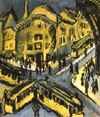
|
|
Aug. 27, 1996
|
Art Watch Index - Aug. 20, 1996
|
|
![]()

Fernand LÉEGER
Ernst Ludwig KIRCHNER
Robert DELAUNAY
LE CORBUSIER
Horst von HARBOU
Giorgio DE CHIRICO
Centre National d'Art et de Culture Georges Pompidou |
La Ville Modern en Europe 1870-1996 - Visions Urbaines d'Artistes et Architectes + Tokyo: La Ville Modern
"La Ville" held at The Pompidou Center reconstructed as the "Tokyo: La Ville Modern" exhibition The "Exhibition of Visual Art Related to the City", which was to be held as part of the "City Exposition", possesses a scale large enough to fill the Museum of Contemporary Art, Tokyo -- a museum often described as having various problems due to its extensive size -- making it look like a "packed sushi box" reminding us also of the city of Tokyo. Putting aside the pros and cons of the City Expo, for this particular exhibition, I feel that a large exhibition space was necessary. At the reception, bands similar to street performers and performing arts groups were invited. The atmosphere was fully qualified for an "exposition". The shock given by the modern age to the city, and the shock the city gave to the modern age The city which was in sleep before 1870 among "serious" urban plan drawings and the unpopular monochromatic panoramic photographs, became reconsidered as a space for people to breathe and live with the achievements of the salon painters who revolted against the academy, represented by the artist, Courbet. Gradually, with the increase of bird's eye plans and as the city started to breathe as a space carrying potential for a grand dream, the Impressionist painters went "outdoors", and by experiencing the city with all their senses, they expressed the city filled with seasonality and various events. The city started to take on a colorful and active look. Soon, the fin de siecle was to arrive as the "night which bears the new world". From here on, as the world wars approached, enormous urban plans, including those which became realized and those which did not become realized, were presented, and simultaneously, the Avant Garde was introduced. Cubism indicated a new way of looking at the world, and the Futurists captured the energy brimming in urban technology. Le Corbusier appeared at the apex of this movement. The new creative will, without knowing, started to expose the true face of the desire towards a destructive megalomania. Thus, the world wars arrived as if they were summoned out of necessity, and through them, the city truly achieved change. The totalitarian ambition, the prosecution by the film, "Metropolis", and the reduction to ashes... In Europe, which became a place of ruins, new urban plans were attempted, and after this, there followed the well-known post-war art movements. Grand urban plans, which now only have room to develop into vitual reality, still continue. In Japan, the fertility of graphic art beginning with Ukiyoe is quite a sight. One cannot help being awe struck by the power of the "one-dimension" in Japan.
The volume of the exhibition is awesome, but unfortunately, the focus of the themes are not refined. Roughly looking through the exhibition, it is similar to a trade fair for old maps and paintings. In order to take a tour and feel that one has gained knowledge, he should go to the exhibition in the morning, buy the catalogue during the tour, read it during lunch, and later take another tour around the exhibition. [Chie KAIHOTSU/Art Critic]
|
|
|
|
|
|
|
|
|
Aug. 27, 1996
|
[home]/[Art Information]/[Column]
[nmp Forum]
Copyright (c) Dai Nippon Printing Co., Ltd. 1996
Network Museum & Magazine Project / nmp@acs.dnp.co.jp





 Hiroshige UTAGAWA III
Hiroshige UTAGAWA III